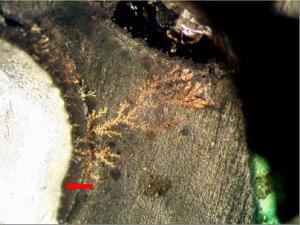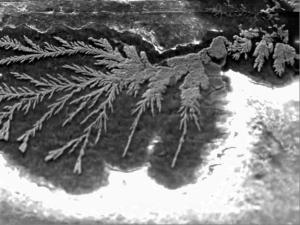Process Contamination
Gideon Analytical Laboratories performed failure analysis on one opened splitter module LPF-200 PCB encapsulated in the black urethane potting material and housed in plastic. The PCB was burnt in one spot, and in that spot, a cavity existed under the carbonized epoxy of the PCB adjacent to the PTH. The trace line had a number of craters strongly suggesting an “electromigration” of copper. In order for electromigration to occur with copper a voltage, an acid and medium (moisture) must be present.
The two pictures above show the presence of numerous dendrites coming from the base of the PTH. The micrograph on the right is a closer look of the same area. SEM-EDS spectral analysis revealed the dendrites consisted mainly of copper with a trace of tin. Dendrites precipitate from a medium like water when it evaporates. The copper appeared to be dissolving in a weak acid solution and migrating because of a voltage potential placed on the electrolyte between either PTH(s) or trace lines.
The final conclusion was that the copper dendrites were present because of exposed copper at the PTH. The exposed copper was migrating because it is being dissolved in acid (coming from either a water-soluble flux or phosphoric acid used in some synthetic fluxes). The dissolved acid in moisture makes this an excellent electrolyte which when a potential is applied will make the copper migrate. As the electrolyte evaporates, the copper will precipitate out forming dendrites and shorting, if a copper makes a connection (as it did in the failure site) between any two potential differences (the trace line and the PTH).
Gideon Analytical Laboratories can consistently identify root causes of failure both in the production and the field application of electrical components. Knowing why parts are failing can be invaluable information that can save companies enormous amounts of time and money in the future. If you can find the cause of the failure, then the next step is prevention.

Copper dendrites

Micrograph of copper dendrites